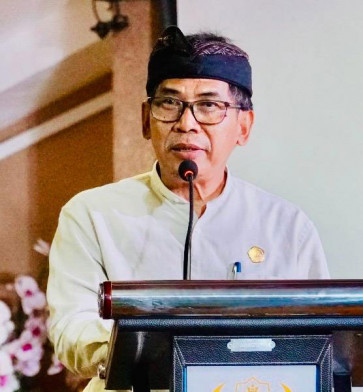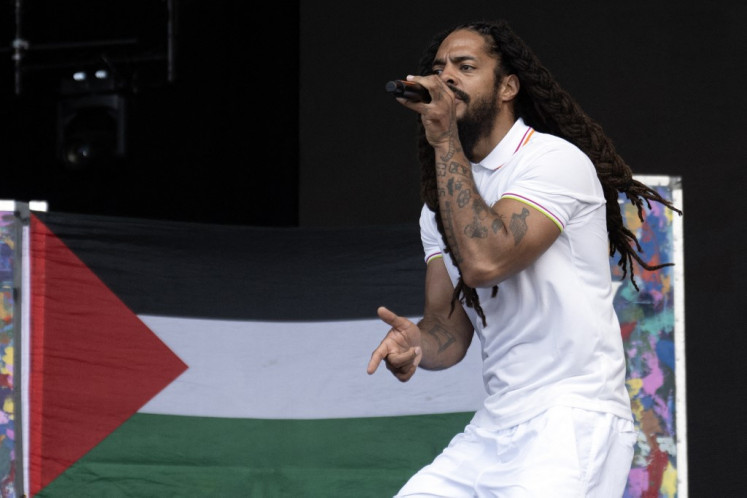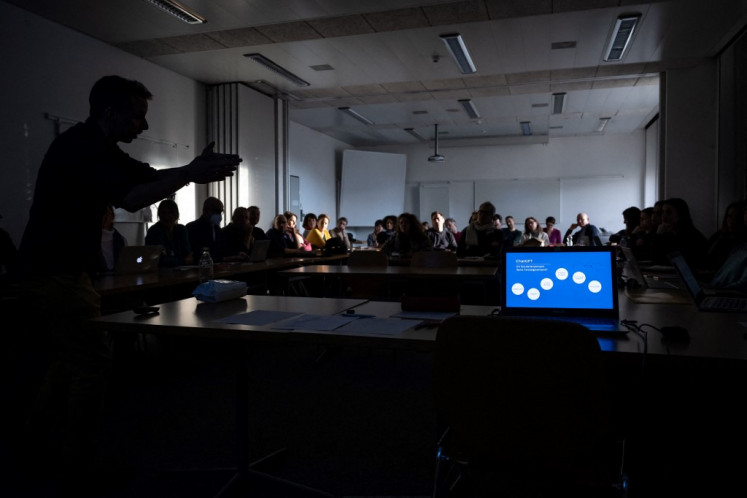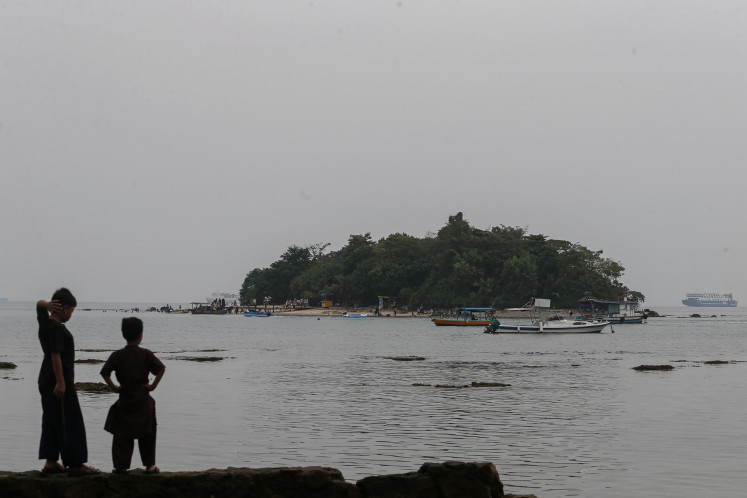Popular Reads
Top Results
Can't find what you're looking for?
View all search resultsPopular Reads
Top Results
Can't find what you're looking for?
View all search resultsParis exhibition shows Henri Cartier-Bresson's work in China
Many of these photos remain among the most iconic in photography, such as Gold Rush in Shanghai.
Change text size
Gift Premium Articles
to Anyone
 Shanghai Gold Rush on Dec. 23, 1948, during the last days of the Kuomintang when people rushed to get their gold deposits out of the banks. (Magnum Photos/Foundation Henri Cartier-Bresson)
Shanghai Gold Rush on Dec. 23, 1948, during the last days of the Kuomintang when people rushed to get their gold deposits out of the banks. (Magnum Photos/Foundation Henri Cartier-Bresson)
P
hotographer Henri Cartier-Bresson always admitted that his first wife of Indonesian descent, known by her dancer name Retno Mohini, triggered his interest in covering independence struggles during Asia’s decolonization process.
They took a cargo ship to India from France in August 1947, arriving after the declaration of Independence. His wife did not always accompany him covering events, which tore apart the former British colony after Muslims left to found the Republic of Pakistan in 1948. Eli, as she was called by close friends, led to Cartier-Bresson’s acceptance by Indians as she wore a sari, understood Indian culture and religions, as well as being a dancer of Indian classical dances, together with Ram Gopal.
After his famous series covering Gandhi’s assassination sold to Life, Saturday Evening Post and Harper’s Bazaar, they left for Burma. During the long photo-journalistic journeys, the photographer wrote his own informative captions, forbidding publications to crop his images.
Here a telegram reached him on Nov. 25, 1948 from Life magazine. The photographer was commissioned to shoot a story on The Last Days of the Kuomintang under Chiang-Kai-Shek, before Maoists took over. Cartier-Bresson flew from Rangoon to Beijing (Peking), initially for only two weeks, leaving Eli behind. With American journalist Bob Ford Doyle and others, he covered the violent fall of the Imperial City.
Afterwards Cartier-Bresson escaped to the Shanghai area and witnessed the fall of Nanjing. Later joined by Eli, they spent time in Shanghai, living frugally with friends like Indian Sam Tata from Black Star agency because the dollar had sky-rocketed. The initial two weeks became almost ten months in China.
His accounts of traditional lifestyles and the establishment of a new order (Beijing, Hangzhou, Nanjing and Shanghai) met with huge success in top international news magazines, including the newly-founded Paris Match. On Sept. 24, 1949, before the People’s Republic of China was proclaimed, the pair succeeded in boarding the SS General Gordon, the only steamer allowed to leave for Hong Kong. The photographer managed to develop his prints and get them through stiff censure.
The following months were important for the photographer and his spouse covering Indonesian Independence, but that is another story.
The long stay in China proved to be a seminal moment in the history of photojournalism. It came at the beginnings of Magnum photo agency which Cartier-Bresson had co-founded 18 months earlier in New York. Magnum photo agency members fiercely protected their copyright and payment for the publication of all their photos with the help of staff members to protect their legal status. Magnum was based in New York and Paris, and later in London.
According to Michel Frizot, curator of the show and author of the book Henri Cartier-Bresson in China, it introduced a new, less event-based, more poetic and detached style, attentive as much to the people as to the balance of the composition, a novel form of the reportage style. Many of these photos remain among the most iconic in photography, such as Gold Rush in Shanghai.
One of the repercussions of China 1948-1949 was that, from the 50s onwards, Henri Cartier-Bresson became a major benchmark in “new” photojournalism and the renaissance of photography in general. The books The Decisive Moment (Verve, 1952) and D’une Chine à l’autre (Delpire, 1954), prefaced by Jean-Paul Sartre, confirmed this supremacy.
The photographer himself often admitted that this was the golden age of photo-reportage which brought him a rich harvest by the exclusive rights to these stories, never to be equaled later. He was able to invest in buying property and controlled the contents of books published by others for him. His sharp intellect also contributed to his international fame as he was able to predict many other political upheavals later in the fifties. Photo exhibitions proliferated as well, with the exclusive sale of his prints.
Cartier-Bresson and Eli left Asia overland by car with two others. An accident in Baluchistan caused Eli to lose the full use of some fingers essential to dance. Their marriage began to unravel afterwards, although she did accompany him on some trips to Germany and other places. Estranged from Cartier-Bresson, Eli, still frequented his close family, later occupying her own flat in Saint-Germain-des-Près.
In 1958, as the 10th anniversary of the People’s Republic of China on Oct. 1 drew closer, Cartier-Bresson set off again on a journey of discovery to the People’s Republic of China, under completely different conditions. This time, constrained by an accompanying guide for four months, he traveled thousands of kilometers, covering the launch of the Great Leap Forward to report on the forced industrialization of rural areas. The photographer with his famous Leica cameras nonetheless succeeded in showing the negative aspects, such as the cruel exploitation of human labor and the hold of the militias. Once again, the reportage met with international success.
Michel Frizot told visitors to the show: “During these two episodes in 1948-1949 and 1958, each profoundly characterized by a contrasting political and social situation, Henri Cartier-Bresson successfully reconfigured the standard model of reportage or stories, while providing magazines with material to demonstrate through their pages this way of ‘looking at life’ which moved him like ‘a kind of constant questioning and immediate answer.”
The exhibition itself at the Fondation HCB displays 114 original prints from 1948-1949, together with 40 prints from 1958 and many hitherto unseen archival documents. For the first time, the entire space of the modulable exhibition premises are taken up by original Henri Cartier-Bresson’s prints.
The show is curated by noted photo-historian Michel Frizot together with Ying-lung Su’s assistance. The artistic director of the show is Agnès Sire, also co-director of the foundation, assisted by the archival collections curator Aude Raimbault. The exhibition is presented with the support of the Gutenberg Agency.
The two photo reportage are combined in the book ‘Henri Cartier Bresson: Chine – 1948-1949/1958’ by Michel Frizot and Ying-Lung Su, published by Delpire Editions, 2019. (kes)
__________
Fondation Henri Cartier-Bresson at 79, Rue des Archives, 75003 Paris
- Open from Tuesday to Sunday from 11 a.m. until 7 p.m.
- Last entry at 6:20 p.m.
- Closed on Monday
- Normal entrance fee is 9 euro (US$10)









